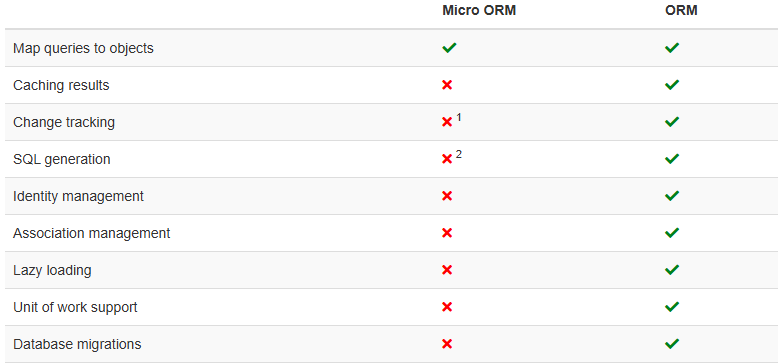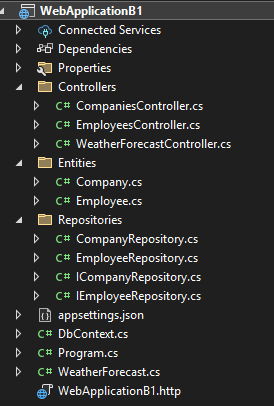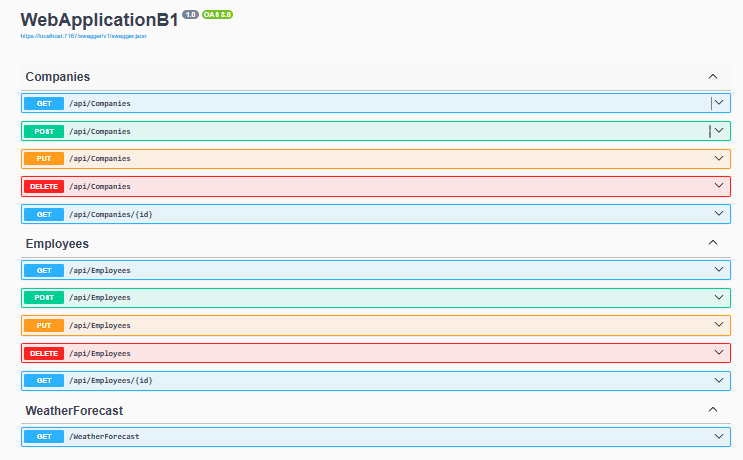Dapper is a micro ORM, while Entity Framework is a full ORM. Dapper was created by the team behind Stack Overflow. Documentation
Is Dapper an ORM?
- Dapper is a micro-ORM, offering only a subset of the functionality of full ORMs like Entity Framework Core.
- Known for speed and simple implementation.
When Should You Use Dapper?
- Primary reason: Performance.
- Ideal for frequent, read-only data that changes often.
- Works well in stateless scenarios (e.g., web apps).
- Requires SQL queries (does not auto-translate .NET code to SQL).
- Best for non-normalized databases with minimal schema expectations.
- Works with any database supporting an ADO.NET provider.
- Dapper is a lightweight, performant, and easy-to-use choice for efficient data access.
- Compatible with .NET Framework and .NET Core.

Implementation of dapper in ASP.NET

1. First create two tables:
CREATE TABLE Companies (
Id INT PRIMARY KEY,
Name NVARCHAR(100),
Address NVARCHAR(255),
Country NVARCHAR(100)
);
CREATE TABLE Employees (
Id INT PRIMARY KEY,
Name NVARCHAR(100),
Age INT,
Position NVARCHAR(100),
CompanyId INT,
FOREIGN KEY (CompanyId) REFERENCES Companies(Id)
);2. Insert some values:
DECLARE @i INT = 1;
DECLARE @companyId INT;
DECLARE @companyCount INT = 10; -- Number of companies
DECLARE @employeeCount INT = 100; -- Number of employees
-- Insert 10 companies first
WHILE @i <= @companyCount
BEGIN
INSERT INTO Companies (Id, Name, Address, Country)
VALUES
(@i,
'Company ' + CAST(@i AS NVARCHAR(10)),
'Address ' + CAST(@i AS NVARCHAR(10)),
'Country ' + CAST(@i AS NVARCHAR(10)));
SET @i = @i + 1;
END
-- Insert 100 employees with random CompanyId or NULL
SET @i = 1; -- Reset counter for employees
WHILE @i <= @employeeCount
BEGIN
-- Randomly decide if employee will have a company or not
IF (RAND() * 2) >= 1 -- 50% chance of assigning a company
BEGIN
-- Assign a random CompanyId (choose from the 10 inserted companies)
SET @companyId = (SELECT TOP 1 Id FROM Companies ORDER BY NEWID());
INSERT INTO Employees (Id, Name, Age, Position, CompanyId)
VALUES
(@i,
'Employee ' + CAST(@i AS NVARCHAR(10)),
FLOOR(RAND() * (60 - 20 + 1)) + 20, -- Random age between 20 and 60
'Position ' + CAST(@i AS NVARCHAR(10)),
@companyId);
END
ELSE
BEGIN
-- Employee has no company (CompanyId = NULL)
INSERT INTO Employees (Id, Name, Age, Position, CompanyId)
VALUES
(@i,
'Employee ' + CAST(@i AS NVARCHAR(10)),
FLOOR(RAND() * (60 - 20 + 1)) + 20, -- Random age between 20 and 60
'Position ' + CAST(@i AS NVARCHAR(10)),
NULL); -- No company
END
SET @i = @i + 1;
END3. Check values:
SELECT * FROM Employees;
SELECT * FROM Companies;
SELECT
c.Id AS CompanyId,
c.Name AS CompanyName,
c.Address AS CompanyAddress,
c.Country AS CompanyCountry,
e.Id AS EmployeeId,
e.Name AS EmployeeName,
e.Age AS EmployeeAge,
e.Position AS EmployeePosition
FROM
Companies c
LEFT JOIN
Employees e ON c.Id = e.CompanyId
ORDER BY
c.Id, e.Id;4. Now Create an ASP.NET Core API project and install NuGet:
<ItemGroup>
<PackageReference Include="Dapper" Version="2.1.66" />
<PackageReference Include="Microsoft.Data.SqlClient" Version="6.0.1" />
<PackageReference Include="Microsoft.AspNetCore.OpenApi" Version="9.0.1" />
<PackageReference Include="Swashbuckle.AspNetCore" Version="7.3.1" />
</ItemGroup>5. Add connection string into appsettings.json:
"ConnectionStrings": {
"DefaultConnection": "Server=prod.asdbd.com;Database=SADB;User ID=asdinc;Password=ASD007;TrustServerCertificate=True;"
},6. Add lines in Program.cs:
builder.Services.AddSingleton<DbContext>();
builder.Services.AddScoped<ICompanyRepository, CompanyRepository>();
builder.Services.AddScoped<IEmployeeRepository, EmployeeRepository>();
builder.Services.AddSwaggerGen();
builder.Services.AddControllers();
app.UseSwagger();
app.UseSwaggerUI();7. Add a DbContext.cs:
using Microsoft.Data.SqlClient;
using System.Data;
namespace WebApplicationB1
{
public class DbContext
{
private readonly IConfiguration _configuration;
private readonly string? _connectionString;
public DbContext(IConfiguration configuration)
{
_configuration = configuration;
_connectionString = _configuration.GetConnectionString("DefaultConnection");
}
public IDbConnection CreateConnection() => new SqlConnection(_connectionString);
}
}8. Add two entities:
public class Employee
{
public int Id { get; set; }
public string Name { get; set; }
public int Age { get; set; }
public string Position { get; set; }
public int CompanyId { get; set; }
}
public class Company
{
public int Id { get; set; }
public string Name { get; set; }
public string Address { get; set; }
public string Country { get; set; }
public List<Employee> Employees { get; set; } = new List<Employee>();
}9. Add repository interface:
public interface IEmployeeRepository
{
public Task<IEnumerable<Employee>> GetEmployees();
public Task<Employee> GetById(int id);
public Task<bool> Add(Employee company);
public Task<bool> Edit(Employee company);
public Task<bool> Delete(int id);
}
public interface ICompanyRepository
{
public Task<IEnumerable<Company>> GetCompanies();
public Task<Company> GetById(int id);
public Task<bool> Add(Company company);
public Task<bool> Edit(Company company);
public Task<bool> Delete(int id);
}10. Implement repository:
EmployeeRepository:
using Dapper;
using WebApplicationB1.Entities;
namespace WebApplicationB1.Repositories
{
public class EmployeeRepository : IEmployeeRepository
{
private readonly DbContext _context;
public EmployeeRepository(DbContext context)
{
_context = context;
}
// Get Employees
public async Task<IEnumerable<Employee>> GetEmployees()
{
var query = "SELECT * FROM Employees";
using (var connection = _context.CreateConnection())
{
var employees = await connection.QueryAsync<Employee>(query);
return employees.ToList();
}
}
// Add a new Employee
public async Task<bool> Add(Employee employee)
{
var query = "INSERT INTO Employees (Id, Name, Age, Position, CompanyId) VALUES (@Id, @Name, @Age, @Position, @CompanyId)";
using (var connection = _context.CreateConnection())
{
var result = await connection.ExecuteAsync(query, new
{
employee.Id,
employee.Name,
employee.Age,
employee.Position,
employee.CompanyId
});
return result > 0; // Returns true if the insert was successful
}
}
// Delete an Employee by Id
public async Task<bool> Delete(int id)
{
var query = "DELETE FROM Employees WHERE Id = @Id";
using (var connection = _context.CreateConnection())
{
var result = await connection.ExecuteAsync(query, new { Id = id });
return result > 0;
}
}
// Edit an existing Employee
public async Task<bool> Edit(Employee employee)
{
var query = "UPDATE Employees SET Name = @Name, Age = @Age, Position = @Position, CompanyId = @CompanyId WHERE Id = @Id";
using (var connection = _context.CreateConnection())
{
var result = await connection.ExecuteAsync(query, new
{
employee.Name,
employee.Age,
employee.Position,
employee.CompanyId,
employee.Id
});
return result > 0;
}
}
// Get an Employee by Id
public async Task<Employee> GetById(int id)
{
var query = "SELECT * FROM Employees WHERE Id = @Id";
using (var connection = _context.CreateConnection())
{
var employee = await connection.QuerySingleOrDefaultAsync<Employee>(query, new { Id = id });
return employee; // Returns null if not found
}
}
}
}CompanyRepository:
using Dapper;
using WebApplicationB1.Entities;
namespace WebApplicationB1.Repositories
{
public class CompanyRepository : ICompanyRepository
{
private readonly DbContext _context;
public CompanyRepository(DbContext context)
{
_context = context;
}
// Get all Companies
public async Task<IEnumerable<Company>> GetCompanies()
{
var query = "SELECT * FROM Companies";
using (var connection = _context.CreateConnection())
{
var companies = await connection.QueryAsync<Company>(query);
return companies.ToList();
}
}
// Get Company by Id (including its Employees)
public async Task<Company> GetById(int id)
{
var query = @"SELECT * FROM Companies WHERE Id = @Id;
SELECT * FROM Employees WHERE CompanyId = @Id;";
using (var connection = _context.CreateConnection())
{
using (var multi = await connection.QueryMultipleAsync(query, new { Id = id }))
{
var company = await multi.ReadSingleOrDefaultAsync<Company>();
if (company != null)
{
company.Employees = (await multi.ReadAsync<Employee>()).ToList();
}
return company;
}
}
}
// Add a new Company
public async Task<bool> Add(Company company)
{
var query = "INSERT INTO Companies (Id, Name, Address, Country) VALUES (@Id, @Name, @Address, @Country)";
using (var connection = _context.CreateConnection())
{
var result = await connection.ExecuteAsync(query, new
{
company.Id,
company.Name,
company.Address,
company.Country
});
// Assuming employees are added separately after the company is inserted
if (result > 0 && company.Employees.Any())
{
// Insert employees if any exist
foreach (var employee in company.Employees)
{
var employeeQuery = "INSERT INTO Employees (Id, Name, Age, Position, CompanyId) VALUES (@Id, @Name, @Age, @Position, @CompanyId)";
await connection.ExecuteAsync(employeeQuery, new
{
employee.Name,
employee.Age,
employee.Position,
CompanyId = company.Id
});
}
}
return result > 0;
}
}
// Delete a Company by Id
public async Task<bool> Delete(int id)
{
// Deleting employees associated with the company
var deleteEmployeesQuery = "DELETE FROM Employees WHERE CompanyId = @Id";
var deleteCompanyQuery = "DELETE FROM Companies WHERE Id = @Id";
using (var connection = _context.CreateConnection())
{
// Start by deleting employees
var employeesDeleted = await connection.ExecuteAsync(deleteEmployeesQuery, new { Id = id });
var companyDeleted = await connection.ExecuteAsync(deleteCompanyQuery, new { Id = id });
return companyDeleted > 0;
}
}
// Edit an existing Company
public async Task<bool> Edit(Company company)
{
var query = "UPDATE Companies SET Name = @Name, Address = @Address, Country = @Country WHERE Id = @Id";
using (var connection = _context.CreateConnection())
{
var result = await connection.ExecuteAsync(query, new
{
company.Name,
company.Address,
company.Country,
company.Id
});
return result > 0;
}
}
}
}11. Add Controller:
EmployeesController:
using Microsoft.AspNetCore.Mvc;
using WebApplicationB1.Entities;
using WebApplicationB1.Repositories;
namespace WebApplicationB1.Controllers
{
[Route("api/[controller]")]
[ApiController]
public class EmployeesController : ControllerBase
{
private readonly IEmployeeRepository _employeeRepo;
public EmployeesController(IEmployeeRepository employeeRepo)
{
_employeeRepo = employeeRepo;
}
[HttpGet]
public async Task<IActionResult> GetEmployees()
{
try
{
var employees = await _employeeRepo.GetEmployees();
return Ok(employees);
}
catch (Exception ex)
{
return StatusCode(500, ex.Message);
}
}
[HttpGet("{id}")]
public async Task<IActionResult> GetById(int id)
{
try
{
return Ok(await _employeeRepo.GetById(id));
}
catch (Exception ex)
{
return StatusCode(500, ex.Message);
}
}
[HttpPost]
public async Task<IActionResult> Add([FromBody] Employee employee)
{
try
{
return Ok(await _employeeRepo.Add(employee));
}
catch (Exception ex)
{
return StatusCode(500, ex.Message);
}
}
[HttpPut]
public async Task<IActionResult> Edit([FromBody] Employee employee)
{
try
{
return Ok(await _employeeRepo.Edit(employee));
}
catch (Exception ex)
{
return StatusCode(500, ex.Message);
}
}
[HttpDelete]
public async Task<IActionResult> Delete(int id)
{
try
{
return Ok(await _employeeRepo.Delete(id));
}
catch (Exception ex)
{
return StatusCode(500, ex.Message);
}
}
}
}CompaniesController:
using Microsoft.AspNetCore.Mvc;
using WebApplicationB1.Entities;
using WebApplicationB1.Repositories;
namespace WebApplicationB1.Controllers
{
[Route("api/[controller]")]
[ApiController]
public class CompaniesController : ControllerBase
{
private readonly ICompanyRepository _companyRepo;
public CompaniesController(ICompanyRepository companyRepo)
{
_companyRepo = companyRepo;
}
[HttpGet]
public async Task<IActionResult> GetCompanies()
{
try
{
var companies = await _companyRepo.GetCompanies();
return Ok(companies);
}
catch (Exception ex)
{
return StatusCode(500, ex.Message);
}
}
[HttpGet("{id}")]
public async Task<IActionResult> GetById(int id)
{
try
{
return Ok(await _companyRepo.GetById(id));
}
catch (Exception ex)
{
return StatusCode(500, ex.Message);
}
}
[HttpPost]
public async Task<IActionResult> Add([FromBody] Company company)
{
try
{
return Ok(await _companyRepo.Add(company));
}
catch (Exception ex)
{
return StatusCode(500, ex.Message);
}
}
[HttpPut]
public async Task<IActionResult> Edit([FromBody] Company company)
{
try
{
return Ok(await _companyRepo.Edit(company));
}
catch (Exception ex)
{
return StatusCode(500, ex.Message);
}
}
[HttpDelete]
public async Task<IActionResult> Delete(int id)
{
try
{
return Ok(await _companyRepo.Delete(id));
}
catch (Exception ex)
{
return StatusCode(500, ex.Message);
}
}
}
}Finally, when you run the project, it will display like this:
